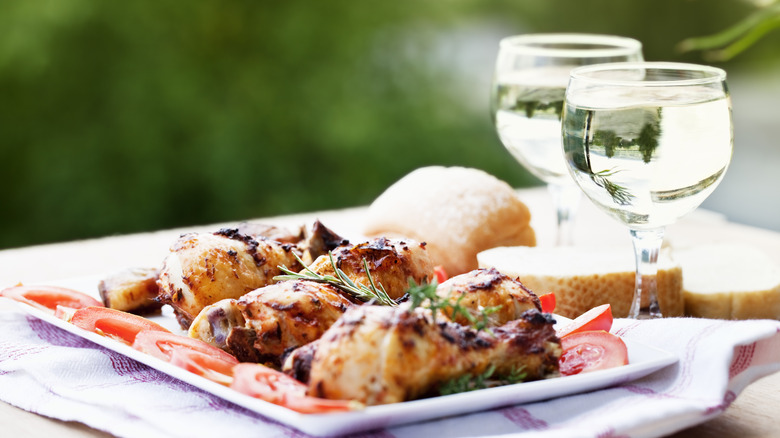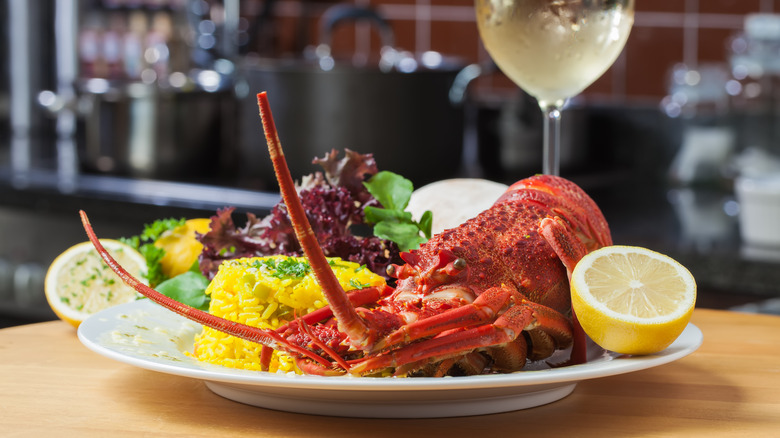What Are The Best Wines To Pair With White Meat?
Drinking and savoring wine on its own is not difficult, but other factors can complicate things. Picking between white, red, sparkling, or dessert wine might rely on a number of variables, like the occasion (a number of celebrations call for sparkling wine) or weather (red wine is typically for colder days). The real challenge, however, is when it comes to pairing the wine with food. Deciding on which wine bottle works best for your meal can flummox anyone, especially if there is a waiter hovering around, waiting for you to make a decision.
As a general rule, red wine goes with darker, gamey meat like beef, lamb, and duck; conversely, it's understood that white wine goes with white meat like chicken, turkey, and seafood. (We will include pork in the latter category for now, although, depending on who you ask, it can be considered the former, or even fall on the spectrum somewhere in between the two.)
You should consider a number of factors choosing a white wine to pair with a white protein, among them seasoning, sauce, and the overall flavor profile of the dish. White wines like chardonnay and sauvignon blanc are good all-rounders here, but there are also underrated options like Riesling, pinot grigio, or Gewürztraminer to take into account.
Chardonnay and sauvignon blanc are classic options
Chardonnay seems to be the workhorse of the wine world; it's a crowdpleaser that compliments a large swathe of dishes. Although no two bottles are the same, chardonnay tends to be a dry, medium-to-full-bodied wine that is rich, crisp, and buttery; it contains a multitude of possible notes (many on the fruity side, and again, depending on the bottle and/or vintage). To make things interesting, there are also variations depending on whether your bottle of chardonnay is oaked or unoaked. An oaked chardonnay is considered a fuller-bodied wine, while unoaked chardonnay, typically fermented in stainless steel, tends to have a crisper taste. Irrespective, this crisp acidity provides a refreshing contrast to a range of chicken and turkey dishes, from grilled chicken salad to roast turkey.
Though some might not think of seafood as "white meat" in the traditional sense, guidelines concerning white wine pairings extend to this protein, too. Dishes like grilled halibut or boiled lobster are delicate, and you want a wine that will not overpower it. Enter sauvignon blanc, a no-regrets pairing. It is a dry, full-flavored wine with mineral and citrus notes, and it works well with entrees that feature fish and crustaceans as the hero because of the combination of acidity from the former and saltiness from the latter.
Gewürztraminer works with spice-heavy, robustly-flavored food
Despite these easy-to-remember tips, there are some exceptions. Pork dishes do not have clear rules for what type of wine they should be paired with, and in the end, it all boils down to the type and flavor profile of the dish in question. If you are using a fatty piece of pork meat to make, say, roasted pork belly, use an acidic white wine like sauvignon blanc, or even, reisling to cut through the fat. However, if you are making pulled pork tacos – ones slathered in juicy and heavy barbecue sauce, in this scenario — a light red wine would be a better option than a standard white.
For overtly spiced dishes with prominent flavors, Gewürztraminer might be your best bet, irrespective of what type of white meat you're eating. This aromatic wine can either be sweet or dry, and the dry version works like a treat with Middle Eastern, Thai, and Indian dishes — think chicken tagine, tom yum soup, or prawn curry.
Experimenting with different wine varieties can lead to some delightful discoveries that, in the end, can only benefit and enhance your dining experience. Ultimately, the art of wine pairing is a personal journey, so feel free to explore and find the combination that resonates best with your palate.


